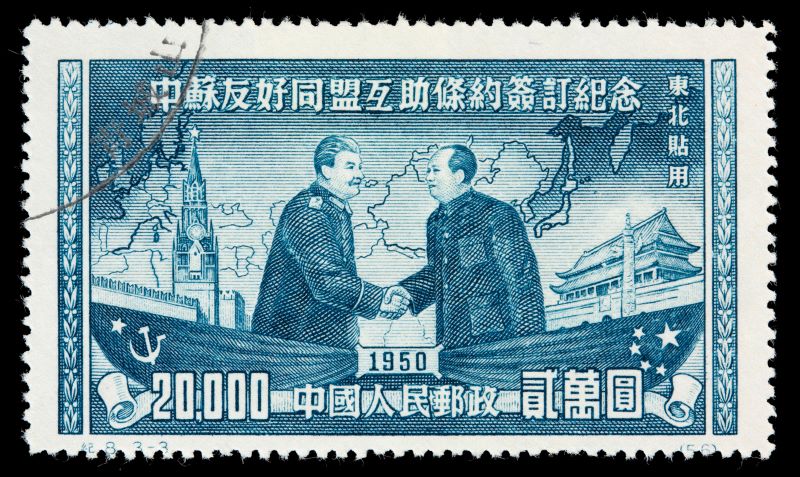| By J. Robert Parks |
If you had told someone seventy-five years ago that between the Soviet Union and the People’s Republic of China, one country would still be ruled by the communists in the twenty-first century, few people (at least in the West) would have guessed China. The Soviet Union had been ruled by the communists for thirty years, and it had helped defeat Nazi Germany and solidified its control over Eastern Europe. In 1950, the PRC had only come into being the year before, with the communists’ victory in China’s civil war. But the conflict had ravaged the country, and China was seen as having significant challenges, ill-equipped to thrive in the modern era. So when the Sino-Soviet Treaty of Friendship, Alliance, and Mutual Assistance was signed seventy-five years ago today, almost everyone viewed it as an agreement between senior and junior partners. The relationship between those two countries over the next four decades had a profound effect on the world, and Gale In Context: World History has an abundance of resources for educators and librarians looking to help students understand how China became one of the world’s great powers again and why the Soviet Union eventually split apart.
Scholars debate when Mao Tse-tung became the undisputed leader of the Communist Party in China, but he had clearly seized control by the early 1940s, taking advantage of the geopolitical situation to lead the communists to victory in 1949. So it was Mao and Soviet leader Joseph Stalin who signed the treaty pledging non-interference in each other’s affairs, but the promise of support if either was attacked. Most importantly for Mao, the treaty also included a $300 million loan from the Soviet Union as well as economic advisors to help right the Chinese economy after years of Japanese occupation and war. Mao responded by declaring that the Soviet Union was a model for China to emulate.
Within months of signing the treaty, the Korean War began, with the communist North Koreans invading South Korea, and the United States responding with military assistance to bolster South Korea. Neither the Soviet Union nor China were enthusiastic about North Korea’s ambitions. In particular, Stalin feared that direct Soviet involvement could lead to a nuclear war. China, however, saw the U.S. involvement as an existential threat.
U.S. foreign policy had supported Chiang Kai-shek and the Nationalists even after they retreated to Taiwan, arguing that they were still the true rulers of China. If the United States and South Korea were able to prevail, that would put U.S. forces on the Chinese border, with the possibility that the United States might try to overthrow Mao’s Communist Party—which is why China committed its military forces to the war, while the Soviet Union didn’t. The Korean War ended in a stalemate in 1953, and the border between the two Koreas has remained one of the most militarized in the world.
In the years following, the Soviet Union and China often pursued different foreign policies despite being theoretically committed to a global communist revolution. Then in 1956, in a secret-but-now-famous speech at the Twentieth Congress of the Communist Party of the Soviet Union, the new Soviet leader, Nikita Khrushchev, denounced Stalinism for its excesses. Mao was outraged for multiple reasons. He believed that, with Stalin dead, he was the ideological leader of the communist world and, therefore, Khrushchev should’ve consulted with him before making such a speech. Second, the condemnation of Stalinism was perceived as an indirect attack on Mao, who was pursuing many of the same policies Stalin had. Finally, Khrushchev had indicated a more peaceful approach to the United States, which Mao saw as an accommodation of Western imperialism and therefore a betrayal of communist ideals.
The rupture between the two countries only deepened in the years to come, with the Soviet Union reducing its aid to China and the two nations bickering over everything from their mutual border to how to support communism overseas. By 1972, Mao welcomed a thawing of relations with the United States as a way of balancing China’s increasing belligerent relations with the Soviet Union.
The differences between the two communist countries came into even starker contrast in 1989. As both faced pro-democracy protests, the Soviet Union acceded to protestors’ demands, allowing for the liberation of its Eastern European allies and then consenting to the breakup of the Soviet Union itself. China’s communist leaders responded by crushing the demonstrators in Tiananmen Square, and the party has remained in control ever since.
About the Author
J. Robert Parks is a former professor and frequent contributor to Gale InContext: U.S. History and Gale In Context: World History who enjoys thinking about how our understanding of history affects and reflects contemporary culture.


